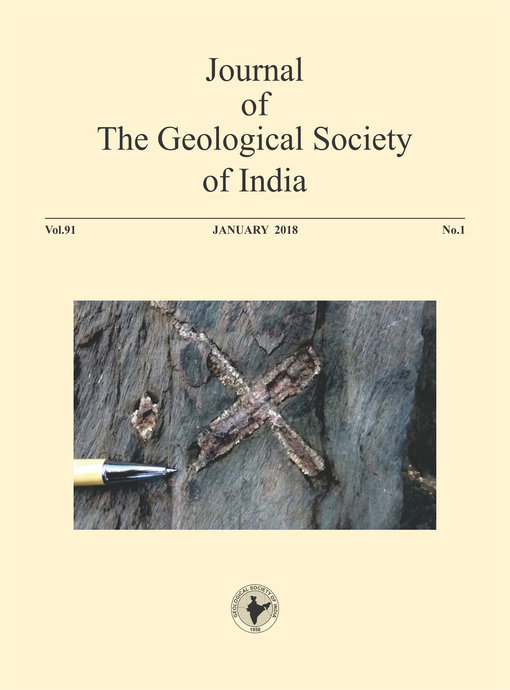Seismic Moment Release Data in Earthquake Catalogue: Application of Hurst Statistics in Delineating Temporal Clustering and Seismic Vulnerability
DOI:
https://doi.org/10.1007/s12594-018-0815-zAbstract
Sequential cumulative moment release data of macroearthquakes (Mw≥4.3) of seventeen seismic zones (A to Q) belonging to NE-Himalaya, Burmese-Andaman arc and West- Sunda arc are analysed by Hurst analysis, a non-parametric statistical procedure to identify clustering of low and high values in a time series. The moment release in a zone occurs in alternate positive, negative and positive sloping segments forming a wave like pattern with intervening small horizontal segment. The negative sloping segments indicate decelerated moment release pattern or temporal slackening of elastic strain release with high b-value (>0.95). The horizontal segment indicates temporal clustering of moderate magnitude events/seismic moments with moderate b-values (0.8-0.95). The positive segment is characterised by accelerated moment release within a short span of time indicating temporal clustering of larger magnitude earthquakes/seismic moments and exhibit lowest b-value (<0.7). All zones attest moderate to high Hurst K values, range 0.7-0.86. The pattern in Hurst plots, specially a reversal of trend after prolong negative slope is used for earthquake prognostication in the seismic zones. Our analysis shows that most of the zones register a notable reversal of Hurst clustering trend after a prolonged negative slope which is accompanied by a major earthquake near its end. However, South Burma region (Zone-I) and Tripura fold belt and Bangladesh Plain (Zone-K) do not show any moderate or large shock around the end of the negative sloping trend in Hurst plot. Hence, these two zones can be considered more prone to produce moderate to larger earthquakes in future.Downloads
Metrics
Issue
Section
Downloads
Published
How to Cite
References
Aki, K. (1965) Maximum likelihood estimate of b in the formula log N = a – bM and its confidence limits. Bull. Earthquake Res. Inst., Tokyo Univ., v.43, pp.237-239.
Chen, C., and Hiscott, R.N. (1999) Statistical analysis of turbidite cycles in submarine fan successions: Tests for short term persistence. Jour. Sed. Res., v.69, pp.486-504.
Curray, J.R. (2005) Tectonics and history of the Andaman Sea region. Jour. Asian Earth Sci., v.25, pp.187-232.
Evans, T.E. (1996) The effects of changes in the world hydrological cycle on availability of water resources. In: F. Bazzaz and W. Sombrock (Eds.), Global Climate Change and Agricultural Production: Direct and Indirect Effects of Changing Hydrological, Pedological and Plant Physiological Processes, Chapter 2, FAO and John Wiley, Whichester.
Feeder, J. (1988) Fractals, Plenum, New York, 283p.
Feng L., and Zhou, J. (2013) Trend predictions in water resources using rescaled range (R/S) analysis. Environ. Earth Sci., v.68(8), pp.2359–2363.
Hanks, H.C., and Kanamori, H. (1979) A moment magnitude scale. Jour. Geophys. Res. v.84, B5, pp.2348-2350, DOI: 10.1029/JB084iB05p02348.
Haslett, J. and Raftery, A.E. (1989) Space-time modelling with long-memory dependence: assessing Ireland's wind power resource. Appl. Stat., v.38(1) pp.1-50, DOI: 10.2307/2347679.
Hurst, H.E. (1951) Long term storage capacity of reservoirs. Tran. Amer. Soc. Civil Engg., v.16, pp.770-808.
Hurst, H.E. (1956) Methods of using long-term storage in reservoirs. Proc. Inst. Civil Eng., Part 1, 5, pp.519-590.
Hernandez-Martinez, E., Perez-Muñoz, T., Velasco-Hernandez, J. X., AltamiraAreyan, A., Velasquillo-Martinez, L. (2013) Facies Recognition Using Multifractal Hurst Analysis: Applications to Well-Log Data. Mathematical Geosciences, v.45(4), pp.471–486
Koutsoyiannis, D. (2003) Climate change, the Hurst phenomenon, and hydrological statistics. Hydrol. Sci. Jour., v. 48(1), pp.3-24, DOI: 10.1623/ hysj.48.1.3.43481.
Mandelbrot, B. and Hudson, R.L. (2004) The (Mis)Behavior of Markets, A Fractal View of Risk, Ruin and Reward. Basic Books – Business & Economics, 328p.
Mansukhani, S. (2012) The Hurst Exponent: Predictability of Time Series. Analytics Magazine, IssueJuly/August 2012, http://analytics-magazine.org/the-hurst-exponent-predictability-of-time-series/
Markonis, Y., and Koutsoyiannis, D.(2013) Climatic Variability Over Time Scales Spanning Nine Orders of Magnitude: Connecting Milankovitch Cycles with Hurst–Kolmogorov Dynamics. Surveys in Geophysics, v.34 (2), pp.181–207
McGuire, R.K. (2004) Seismic Hazard and Risk Analysis, EERI Monograph 10, Earthquake Engineering Research Institute, Oakland, California, 221p.
Miao, L., Jiang, C., Xue, B., Liu, Q., He, B., Nath, R., and Cui X. (2015) Vegetation dynamics and factor analysis in arid and semi-arid Inner Mongolia. Environ. Earth Sci., v.73(5), pp.2343–2352.
Mukhopadhyay, B., Chakraborty, P.P., and Paul,S. (2003) Facies clustering in turbidite successions: Case study from Andaman Flysch Group, Andaman Islands, India. Gondwana Res., v.6(4), pp. 918-925, DOI: 10.1016/S1342937X(05) 71036-4.
Mukhopadhyay, B., Acharyya, A., and Dasgupta, S. (2009) Statistical Analysis on Yearly Seismic Moment Release Data to Demarcate the Source Zone for an Impending Earthquake in the Himalaya. Acta Geophysica, v.57 (2), pp.387-399, DOI: 10.2478/s11600-008-0068-0
Scordilis, E.M. (2006) Empirical global relations converting MS and mb to moment magnitude. Jour. Seismol., v.10, pp.225–236.
Shi, P., Wu, M., Qu, S., Jiang,P., Qiao, X., Chen, X., Zhou, M. and Zhang, Z. (2015) Spatial Distribution and Temporal Trends in Precipitation Concentration Indices for the Southwest China. Water Resources Management, v.29(11), pp.3941–3955.
Wallis, J.R. and Matalas, N.C. (1970) Small sample properties of H and K estimators of Hurst coefficient h. Water Resour. Res., v.6(6), pp.15831594, DOI: 10.1029/ WR006i006p01583.
Wallis, J.R., and Matalas, N.C. (1971) Correlogram analysis revisited. Water Resour. Res., v.7(6), pp.1448-1459, DOI: 10.1029/WR007i006p01448.
Wiemer, S. and Wyss, M. (2000) Minimum magnitude of completeness in earthquake catalogs: example from Alaska, the western United States, and Japan. Bull. Seismol. Soc. Amer., v.90(4), pp.859-869.
Weber, R.O. and Talkner, P. (2001) Spectra and correlations of climate data from days to decades. Jour. Geophys. Res., v.106 (D17), pp.20131–20144.

 Basab Mukhopadhyay
Basab Mukhopadhyay






